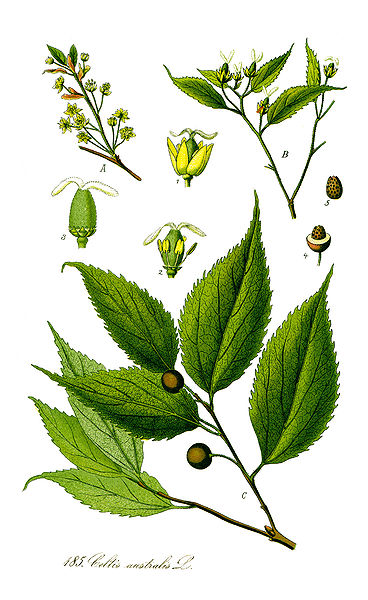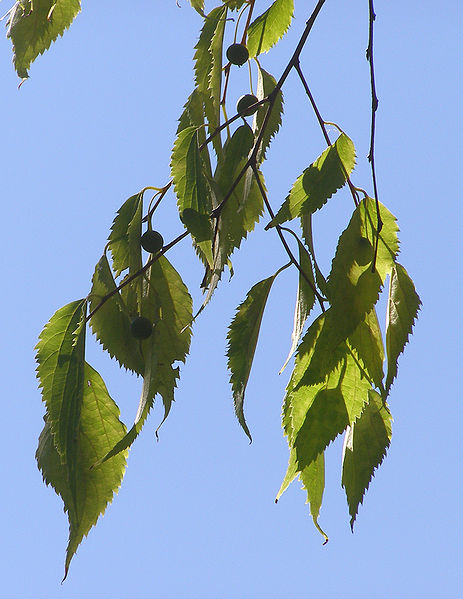 |
|
http://commons.wikimedia.org/wiki/File:Illustration_Celtis_australis1.jpg |
 |
| http://commons.wikimedia.org/wiki/User:Tintazul |
Translate this page:
Summary
Physical Characteristics

 Celtis australis is a deciduous Tree growing to 20 m (65ft) by 10 m (32ft) at a medium rate.
Celtis australis is a deciduous Tree growing to 20 m (65ft) by 10 m (32ft) at a medium rate.
See above for USDA hardiness. It is hardy to UK zone 6. It is in flower in April, and the seeds ripen in October. The species is hermaphrodite (has both male and female organs) and is pollinated by Bees.
Suitable for: light (sandy) and medium (loamy) soils, prefers well-drained soil and can grow in nutritionally poor soil. Suitable pH: mildly acid, neutral and basic (mildly alkaline) soils. It cannot grow in the shade. It prefers dry or moist soil and can tolerate drought.
UK Hardiness Map
US Hardiness Map
Synonyms
C. lutea.
Plant Habitats
Woodland Garden Canopy;
Edible Uses
Edible Parts: Fruit Oil Oil Seed
Edible Uses: Oil Oil
Fruit - raw[3, 7, 100]. A mealy pleasant taste[74]. Small and insipidly sweet[2, 183]. Of little value[177]. The fruit is about 10mm in diameter[200] with a single large seed[K]. Seed - raw or cooked[7, 46, 61, 105]. An oil is obtained from the seed[7, 105].
References More on Edible Uses
Medicinal Uses
Plants For A Future can not take any responsibility for any adverse effects from the use of plants. Always seek advice from a professional before using a plant medicinally.
Astringent Dysentery Lenitive Stomachic
The leaves and fruit are astringent, lenitive and stomachic[7, 254]. The leaves are gathered in early summer and dried for later use[7]. The fruit, particularly before it is fully ripe, is considered to be more effective medicinally[254]. A decoction of both leaves and fruit is used in the treatment of amenorrhoea, heavy menstrual and intermenstrual bleeding and colic[218, 240]. The decoction can also be used to astringe the mucous membranes in the treatment of diarrhoea, dysentery and peptic ulcers[254].
References More on Medicinal Uses
The Bookshop: Edible Plant Books
Our Latest books on Perennial Plants For Food Forests and Permaculture Gardens in paperback or digital formats.

Edible Tropical Plants
Food Forest Plants for Hotter Conditions: 250+ Plants For Tropical Food Forests & Permaculture Gardens.
More

Edible Temperate Plants
Plants for Your Food Forest: 500 Plants for Temperate Food Forests & Permaculture Gardens.
More

More Books
PFAF have eight books available in paperback and digital formats. Browse the shop for more information.
Shop Now
Other Uses
Dye Fuel Oil Oil Wood
A yellow dye is obtained from the bark[100]. A fatty oil is obtained from the seed[243]. No more information is given. Wood - very tough, pliable, durable[46, 61, 158]. Widely used by turners[7]. Used for the handles of agricultural implements[272]. The flexible thin shoots are used as walking sticks[61]. An excellent fuel[146].
Special Uses
References More on Other Uses
Cultivation details
Succeeds in any reasonably good soil, preferring a good fertile well-drained loamy soil[1, 11, 200]. Succeeds on dry gravels and on sandy soils[200]. The trees have deep spreading roots[7] and are very drought resistant once established[74, 200]. This species requires mild winters if it is to succeed[3]. Trees prefer hotter summers and more sunlight than are normally experienced in Britain, they often do not fully ripen their wood when growing in this country and they are then very subject to die-back in winter[1, 11, 200]. A hardier form, from seed collected in the Caucasus, is in cultivation in Britain[11]. The fruit and the seed are sometimes sold in local markets in the Balkans[46, 183]. This plant is said to be the lotus fruit of the ancients[183]. It is mentioned in the story of Odysseus returning from Troy and the story relates that if a person should eat the fruit they will never leave that area. Coppices well[146]. A good shade tree[200]. Trees can be very long-lived, perhaps to 1000 years[200]. Plants in this genus are notably resistant to honey fungus[200].
References Carbon Farming Information and Carbon Sequestration Information
Temperature Converter
Type a value in the Celsius field to convert the value to Fahrenheit:
Fahrenheit:
The PFAF Bookshop
Plants For A Future have a number of books available in paperback and digital form. Book titles include Edible Plants, Edible Perennials, Edible Trees,Edible Shrubs, Woodland Gardening, and Temperate Food Forest Plants. Our new book is Food Forest Plants For Hotter Conditions (Tropical and Sub-Tropical).
Shop Now
Plant Propagation
Seed - best sown as soon as it is ripe in a cold frame[200]. Stored seed is best given 2 - 3 months cold stratification and then sown February/March in a greenhouse[78, 200]. Germination rates are usually good, though the stored seed might take 12 months or more to germinate. The seed can be stored for up to 5 years[113]. As soon as they are large enough to handle, prick the seedlings out into individual pots. The leaves of seedlings often have a lot of white patches without chlorophyll, this is normal and older plants produce normal green leaves. Grow the seedlings on in a cold frame for their first winter, and plant them out in the following late spring or early summer[K]. Give them some protection from the cold for their first winter outdoors. Cuttings
Other Names
If available other names are mentioned here
Native Plant Search
Search over 900 plants ideal for food forests and permaculture gardens. Filter to search native plants to your area. The plants selected are the plants in our book 'Plants For Your Food Forest: 500 Plants for Temperate Food Forests and Permaculture Gardens, as well as plants chosen for our forthcoming related books for Tropical/Hot Wet Climates and Mediterranean/Hot Dry Climates. Native Plant Search
Found In
Countries where the plant has been found are listed here if the information is available
Weed Potential
Right plant wrong place. We are currently updating this section.
Please note that a plant may be invasive in one area but may not in your area so it’s worth checking.
Conservation Status
IUCN Red List of Threatened Plants Status :

Growth: S = slow M = medium F = fast. Soil: L = light (sandy) M = medium H = heavy (clay). pH: A = acid N = neutral B = basic (alkaline). Shade: F = full shade S = semi-shade N = no shade. Moisture: D = dry M = Moist We = wet Wa = water.

Expert comment
Author
L.
Botanical References
11100200
Links / References
For a list of references used on this page please go here
Readers comment